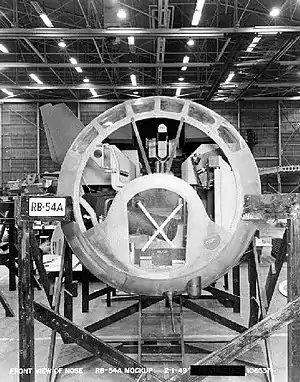| B-54 | |
|---|---|
 | |
| Mockup of the B-54 | |
| Role | Strategic bomber |
| National origin | United States |
| Manufacturer | Boeing |
| Status | Canceled |
| Primary user | United States Air Force (intended) |
| Number built | 0 |
| Developed from | B-50 Superfortress |
The Boeing B-54 was an American strategic bomber designed by Boeing for use by the United States Air Force. Derived from the YB-50C Superfortress, construction of the prototype was canceled before completion, and the aircraft was never flown.
Design and development
Begun in 1947, the B-54 was the planned production version of the YB-50C prototype. The standard Pratt & Whitney R-4360 engines of the normal B-50 bomber were replaced with R-4360-51 Variable Discharge Turbine (VDT) engines, the fuselage was lengthened by over 10 feet (3.0 m) and the wingspan was extended by 20 feet (6.1 m), which required the installation of outrigger landing gear in the first and fourth engine nacelles. Large fuel tanks under the outboard wing section were required to carry an additional 3,000 US gallons (11,000 L; 2,500 imp gal) of fuel to reach the intended 9,300 miles (15,000 km) range; 14 .50-caliber machine guns comprised the specified defensive armament.[1]
On May 29, 1948, contracts were placed by the Air Force for 14 B-54A bombers and 29 RB-54A reconnaissance aircraft.[2][3][4][1] However, on April 18, 1949, the B-54 project was cancelled due to the development of better-performing jet aircraft; construction of the prototype B-54A had started at Seattle but was never completed.[1] The cancellation was lambasted by the Seattle press, who claimed that it was a political decision instead of a military one.[5]
Variants
- B-54A
- Intended production version of the YB-50C
- RB-54A
- Reconnaissance version
Specifications
Data from [2]
General characteristics
- Crew: 10
- Length: 111 ft (34 m)
- Wingspan: 161 ft 0 in (49.08 m)
- Height: 32 ft 8 in (9.96 m)
- Gross weight: 230,000 lb (104,326 kg)
- Powerplant: 4 × Pratt & Whitney R-4360-51 radial piston Turbo-compound engine, 4,500 hp (3,400 kW) each
Performance
- Maximum speed: 430 mph (690 km/h, 370 kn)
- Cruise speed: 305 mph (491 km/h, 265 kn)
- Range: 9,000 mi (14,000 km, 7,800 nmi)
- Ferry range: 10,562 mi (16,998 km, 9,178 nmi)
- Service ceiling: 40,000 ft (12,000 m) service
Armament
- Guns: 14 × .50-caliber machine guns in turrets
- Bombs: 36,000 pounds (16,000 kg)
See also
Related development
Aircraft of comparable role, configuration, and era
Related lists
References
Notes
Citations
Bibliography
- Jones, Lloyd S (1974) [1962], U.S. Bombers, B-1 1928 to B-1 1980s (2nd ed.), Fallbrook, CA: Aero Publishers, ISBN 0-8168-9126-5.
- "Factsheets: Boeing B-54A". National Museum of the United States Air Force. July 7, 2009. Archived from the original on June 16, 2012. Retrieved 2017-07-09.
- Olson, James C. (2003). Stuart Symington: A Life. Columbia, MO: University of Missouri Press. ISBN 978-0-82621503-1.
- Redding, Robert; Yenne, Bill (1989). Boeing: Planemaker to the World. New York: Crescent Books. ISBN 978-0-51742270-0.
- Swanborough, F. G. and Peter M. Bowers. United States Military Aircraft since 1909. Washington, DC: Smithsonian Institution Press, 1989. ISBN 978-0-87474880-2.
- Wagner, Ray (1968). American Combat Planes. New York: Doubleday. ISBN 978-0-38504134-8.